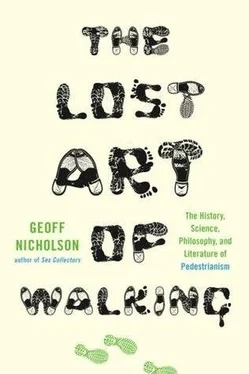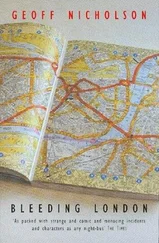The combination of speed and endurance was what made a great walker, but Barclay’s greatest challenge and success, the walk that was to make his name forever, involved only the latter. In 1809, Barclay went for the big one, the one that Richard Long’s 1974 art piece alluded to, and wagered that he could walk a mile in each of a thousand successive hours, for a prize of one thousand guineas. The event started on June 1 on Newmarket Heath and, if all went well, was due to end on the afternoon of July 12.
There’s something elegant and elemental about those grand, high, rounded numbers, but paradoxically there’s also something that sounds quite simple and straightforward. An average speed of one mile per hour is insultingly slow, and walking twenty-four miles in a day is not much of a problem for anyone who considers himself a serious walker. Even walking a thousand miles in just less than six weeks is well within the range of the possible. The problem is having to walk just a mile in every single hour. Think about it.
If you go at four miles per hour, that means that in each hour you’re walking for fifteen minutes, and at rest for forty-five. If you join two miles together, the last fifteen minutes of one hour leading straight into the first fifteen of the next, that still only gives you a maximum of an hour and a half’s rest before you have to start walking again. And naturally enough you slow down as the event goes on. The challenge is all about endurance, but over the course of the six weeks it seems to have as much to do with enduring sleep deprivation as it does with being able to walk a vast distance.
Barclay, of course, succeeded. Once per hour every hour for one thousand hours he walked a single mile on a set course in Newmarket, in Suffolk. He actually changed the course partway through the event when he changed his lodgings, on day sixteen, but the rules remained the same. Barclay struggled, he endured, he succeeded. If his stride was a yard long, then he made 1,760,000 strides.
It was, by all accounts, a huge public event. Vast crowds gathered to see Barclay, though most of them must have seen very little, and I imagine many came for the freak-show element rather than to witness a great sporting achievement. To a modern sensibility the sight of a man walking briskly for fifteen to twenty minutes at a time doesn’t sound like rich entertainment, so surely the crowds must have come to see his suffering and agony, perhaps to see him collapse, or even expire like Abraham Wood. Partway through the event the Edinburgh Advertiser gleefully reported, ‘Captain Barclay was pursuing his extraordinary undertaking yesterday, but as he proceeds, the hopes of accomplishing it become ever more feeble’. Perhaps they were disappointed that he succeeded, that he lived. Barclay showed them all. He did the deed, won his money, slept for some, not too many, hours, and then joined his regiment, based outside Deal, and went off to fight Napoleon.
♦
Barclay’s walking expressed something singular and profound about himself and about the human condition, demonstrating what the human body and the human spirit are capable of. His walking was something in the world and of the world, something natural but also something created and willed. Money was part of his motivation, fame and glory, too, but there was surely something inexplicable and irreducible about his obsessive walking, something that remains compelling and admirable, and ultimately mysterious, to this day.
Barclay didn’t do drawings or text pieces or mud sculptures as part of his walk, but he did contribute to a book. Its full title is Pedestrianism, or, an account of the performances of celebrated pedestrians during the last and present century, with a full narrative of Captain Barclay’s public and private matches, and an essay on training , and it’s attributed to Walter Thorn. Barclay appears as the book’s hero rather than its author, but he provided a good deal of inside information about himself and about walking in general. The third person allows the singing of his praises in ways that would have appeared boastful or arrogant if he’d put his own name on it.
Half the book is an anecdotal history of walking, but the main section describes Barclay’s walk, how he looked while he walked, with…
‘…a sort of lounging gait, without apparently making any extraordinary exertion, scarcely raising his feet more than two or three inches above the ground…His style of walking is to bend forward the body, and to throw its weight on the knees………Any person who will try this plan will find, that his pace will be quickened, at the same time he will walk with more ease to himself, and be better able to endure the fatigue of a long journey, than by walking in a posture perfectly erect, which throws too much of the weight of the body on the ancle-joints [sic]’.
It describes his diet: roasted fowl (hot and cold), strong ale, tea, bread and butter, beefsteaks, mutton chops, porter, wine, and ‘such vegetables as were in season’. And above all it describes his difficulties and his pain. ‘The spasmodic affections in his legs were particularly distressing’, we’re told. They started on day twelve in his calves, thighs, and feet, and got worse until he was in ‘great pain’ by day twenty. By day thirty-three ‘he could not rise up without assistance’. On day thirty-four he couldn’t move without crying out. By day thirty-six, says Thorn, he was walking so slowly it significantly reduced the amount of time he had to rest, though this is scarcely borne out by another part of the book.
A section at the end gives ‘box scores’ for Barclay’s walk, the statistics of his times, speeds, totals, averages, and so on. His first mile, for example, was done in a brisk twelve minutes, and although he gradually slowed down, he was still moving along very nicely. On day eighteen he was still averaging under seventeen minutes per mile — on day thirty-six, after he’d covered well over eight hundred miles, he was still averaging only a tad over twenty minutes — and his slowest mile in the whole event was only twenty-five minutes. His thousandth mile was walked in just twenty-two minutes and would have been quicker, but there were so many spectators crowding around and cheering him on, he could barely find room to walk.
♦
About fifty years later an Australian called Allan McKean performed a similar thousand-mile, thousand-hour walk. He completed the feat in late 1858 in Ballarat, in Victoria, then incredibly did it again a few weeks later in Melbourne, ending this second walk in early 1859. The Melbourne Argus reported that ‘he completed his thousandth mile (actually his two thousandth) in fifteen minutes thirty-nine seconds, and appeared to be as little fatigued as when he had accomplished one-half of his allotted distance’.
I’m sure I ought to be doubly impressed by McKean’s feat, and nobody could possibly belittle it, and yet in the end Captain Barclay remains the man that I, and history, have more respect and affection for. To be the first to do something is inevitably going to be a lot more impressive than to be the first to do it twice.
Twenty years later, two women in America did something that I sometimes feel is more impressive still, certainly more difficult, I think. In 1879, in Brooklyn, an Englishwoman named Ada Anderson walked 2,700 quarter miles in 2,700 consecutive quarter hours. Two years later this record was broken by the exotically named Exilda La Chapelle at the Folly Theatre in Chicago, who completed 3,000 quarter miles in 3,000 quarter hours.
Clearly both these women walked considerably shorter distances than Barclay or McKean, but what makes their walks so compelling, and so much more difficult, is the severe reduction in the periods allowed for rest and recovery. These can never have been more than a little over twenty minutes each. The poor women must have been hallucinating by the end. The Washington Post reported that watching La Chapelle’s walk was like watching the Spanish Inquisition. Naturally, there was no shortage of spectators.
Читать дальше












